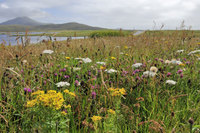Wildlife breaks in the Outer Hebrides the 'Islands on the Edge'

As the BBC natural history series, Hebrides, Islands on the Edge comes to an end this week, many viewers will have been inspired to put the Outer Hebrides on their must-visit list. But can the islands really offer the kind of up-close and personal encounters with wildlife that the series promises?
The answer is a resounding 'Yes!' - the islands live up to all the superlatives they enjoy when it comes to nature. Even the most idle stroll anywhere in the Outer Hebrides will bring visitors face to face with wildlife it's hard to find on the mainland.
In spring and early summer, a tapestry of bird song is the backdrop to a walk across the beautiful west coast flower meadows, known as machair.
Larks, lapwings, oyster catchers, redshank- they're easy to hear and spot. These birds are so commonplace in the Outer Hebrides that residents barely notice them, but for many mainland visitors, it's often first time they've heard or seen them.
The distinctive krek-krek of the corncrake is also easy to hear, but the birds themselves are well-camouflaged and secretive.
A ramble along one of the islands' spectacular beaches where the waves tumble with flocks of little wading birds, dunlins possibly or turnstone or sanderlings.
Sea birds wheel above - from gannets, guillemot and skua to shag, tern and puffin. The Outer Hebrides have some of the largest populations of sea birds in the UK, with St Kilda one of the most important breeding sites for gannets in North-Western Europe.
A boat trip with one of the islands' sea tour operators will enable visitors to see an extraordinary variety of sea-birds, and if they're lucky, whales and dolphins too.
The Minch (between the north west Scottish mainland and the Outer Hebrides) teems with bottle-nosed dolphin, minke whales and basking sharks.
Visitors might be exceptionally lucky and spot Risso's dolphins, which inhabit only a handful of coastal sites where the continental shelf is narrow and close to the shore. The Outer Hebrides is classed as one of their critical habitats.
Grey seals are a common sight - after all, the Outer Hebrides is home to 40% of the world population. And visitors are sure to spot a common seal, as the islands are home to 10% of the European population.
Then it's eyes down for the islands' exceptional flora.
The Outer Hebrides has its own wild orchids, with entire fields studded with them in the early summer, in shades of white to heliotrope. Both moorland and machair play host to more than 700 species of flowering plants and ferns.
A walk over the inland moors of an evening might well bring visitors face to face with red deer. Prepare to be impressed in North Uist - the island has one of the most genetically pure strains of red deer in the UK.
This barely skims the surface of what's available to see in the Outer Hebrides. There are numerous naturalists offering guided walks and tours - and one of the best ways to find out what's around is by falling into conversation with the islands' friendly crofters as they go about their business. They have generations of knowledge to share.
For further information on the wildlife and flora of the Outer Hebrides, as well as plenty more to see and do and where to stay, visit visitouterhebrides.co.uk.

